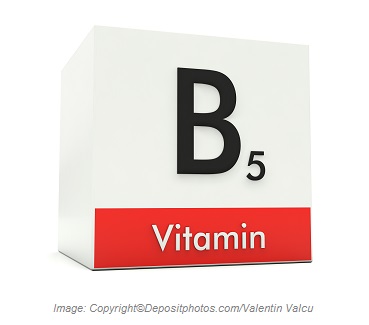 metabolism of carbohydrates and fat, and synthesis of steroid hormones. It is famous as the “anti – stress vitamin”, as it is highly important for normal function of the adrenal glands.
metabolism of carbohydrates and fat, and synthesis of steroid hormones. It is famous as the “anti – stress vitamin”, as it is highly important for normal function of the adrenal glands.
Functions of Vitamin B5:
- It is a constituent of coenzyme A (CoA), which, in the forms of acetyl – CoA and succinyl – CoA, involves in the Krebs cycle, leading to the production of energy (ATP).
- It is required for synthesizing the neurotransmitter acetylcholine.
- It activates the cortex of the adrenal glands to produce cortisol to fight stress. This is why it is called as the “anti – stress vitamin”.
- It is highly important for optimal production of steroid hormones by the adrenal glands. This is why it is called among athletes and exercisers as the “steroid – producing vitamin”.
- It helps the body uses other vitamins especially vitamin B2.
- In the form of CoA, it is crucial for the synthesis of fatty acids, cholesterol, and phospholipids.
Food Sources and Absorption:
Brewer’s yeast, fish and liver are the best food sources of vitamin B5. Other food sources are egg yolks, chicken, legumes, whole grains, yogurt, cheese, royal jelly, avocado, broccoli, cauliflower, mushroom, sweet potatoes, green beans and alfalfa. Small amounts of vitamin B5 are produced by the intestinal flora.
Vitamin B5 is absorbed from the small intestine. Its absorption is  sodium – dependent (active diffusion), though a small amount could be absorbed without sodium help (passive diffusion). The body cannot absorb all dietary vitamin B5, and as dietary intake increases, the absorption may decrease. This is due to saturation of the active transport system.
sodium – dependent (active diffusion), though a small amount could be absorbed without sodium help (passive diffusion). The body cannot absorb all dietary vitamin B5, and as dietary intake increases, the absorption may decrease. This is due to saturation of the active transport system.
Deficiency of Vitamin B5:
Even though deficiency of vitamin B5 is unlikely, people with dysbiosis (imbalance of good and bad bacteria in the intestine), chronic consumers of antibiotics, teenagers, heavy alcohol drinkers and poor dieters are at risk for developing vitamin B5 deficiency. The symptoms may include fatigue, sleep disturbances, nausea, impaired coordination, a decrease in stomach acid, abdominal cramps, recurrent upper respiratory infections, and exacerbation of allergies.
Athletic Benefits of Vitamin B5:
- Helps recover from overtraining syndrome.
- Aids the body cope with the stress of training, competition, and pre – competition anxiety.
- Enhances resistance of the body against infections.
- Supports building muscles by boosting the production of normal steroids of the body.
Non – Athletic Benefits of Vitamin B5:
The following conditions may benefit from vitamin B5:
- High levels of LDL and triglyceride.
- Wound healing especially if combined with vitamin C.
- Diabetic foot.
- Diabetic neuropathy (especially if combined with alpha – lipoic acid).
- Rheumatoid arthritis.
- Bruxism (nighttime teeth grinding).
- Adrenal exhaustion.
- Alzheimer’s disease.
- Psoriasis.
- Acne.
- Systemic lupus erythematous (SLE).
- Asthma.
- Insomnia.
- Allergies.
- Chronic constipation.
Dosage and Side Effects:
The recommended daily intake for vitamin B5 for adults is 5 mg. The recommended doses during pregnancy and breastfeeding are 6 mg and 7 mg, respectively. A dose of 25 – 50 mg a day is considered safe. The performance daily intake (PDI) of vitamin B5 in athletes and physically active adults is 50 – 200 mg. For therapeutic purposes, it could be taken up to 500 mg a day.
A very high dose of vitamin B5 (more than 8 – 10 grams a day) for several weeks could cause diarrhea.
People with the following conditions should be careful when taking vitamin B5:
- Panic disorder.
- Hemophilia.
- Bleeding disorders.
Interactions:
- Tetracycline: vitamin B5 interferes with the absorption of this antibiotic and they should be taken 2 – 4 hours apart.
- Anti – Alzheimer medications: vitamin B5 may increase the effectiveness of these medications.
- Blood thinners: vitamin B5 may increase the effectiveness of these medications and may cause bleeding.

